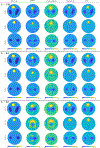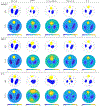3D ELECTRICAL IMPEDANCE TOMOGRAPHY RECONSTRUCTIONS FROM SIMULATED ELECTRODE DATA USING DIRECT INVERSION texp AND CALDERÓN METHODS
- PMID: 35173824
- PMCID: PMC8846426
- DOI: 10.3934/ipi.2021032
3D ELECTRICAL IMPEDANCE TOMOGRAPHY RECONSTRUCTIONS FROM SIMULATED ELECTRODE DATA USING DIRECT INVERSION texp AND CALDERÓN METHODS
Abstract
The first numerical implementation of a t exp method in 3D using simulated electrode data is presented. Results are compared to Calderón's method as well as more common TV and smoothness regularization-based methods. The t exp method for EIT is based on tailor-made non-linear Fourier transforms involving the measured current and voltage data. Low-pass filtering in the non-linear Fourier domain is used to stabilize the reconstruction process. In 2D, t exp methods have shown great promise for providing robust real-time absolute and time-difference conductivity reconstructions but have yet to be used on practical electrode data in 3D, until now. Results are presented for simulated data for conductivity and permittivity with disjoint non-radially symmetric targets on spherical domains and noisy voltage data. The 3D t exp and Calderón methods are demonstrated to provide comparable quality to their 2D counterparts, and hold promise for real-time reconstructions due to their fast, non-optimized, computational cost.
Keywords: Calderón; complete electrode model; complex geometrical optics; conductivity; texp.
Figures














References
-
- Adler A, Arnold JH, Bayford R, Borsic A, Brown B, Dixon P, Faes TJ, Frerichs I, Gagnon H, Gärber Y, and Grychtol B, Greit: a unified approach to 2d linear eit reconstruction of lung images, no. 6, S35–S55. - PubMed
-
- Alsaker M, Hamilton SJ, and Hauptmann A, A direct D-bar method for partial boundary data Electrical Impedance Tomography with a priori information, Inverse Problems and Imaging 11 (2017), no. 3, 427–454.
-
- Alessandrini G, Stable determination of conductivity by boundary measurements, Applicable Analysis 27 (1988), 153–172.
-
- Alsaker M and Mueller JL, A D-bar algorithm with a priori information for 2-D Electrical Impedance Tomography, SIAM J. on Imaging Sciences 9 (2016), no. 4, 1619–1654.
-
- Alsaker M and Mueller JL, EIT images of human inspiration and expiration using a D-bar method with spatial priors, Applied Computational Electromagnetics Society Journal 34 (2019), no. 2.
Grants and funding
LinkOut - more resources
Full Text Sources
